Templo Mayor – Mexico City’s Aztec Centrepiece
Tenochtitlan was the most important city in the Aztec, or more properly Mexica, empire and with a population of between 200,000 and 300,000, one of the largest cities in the world when Hernan Cortés arrived in 1521. The Spaniards were simply blown away, not only by its size, but by the beauty and majesty of the many temples and palaces of which Templo Mayor was the crown jewel. Located within the Sacred Precinct, it was the absolute centre of the Mexica world.
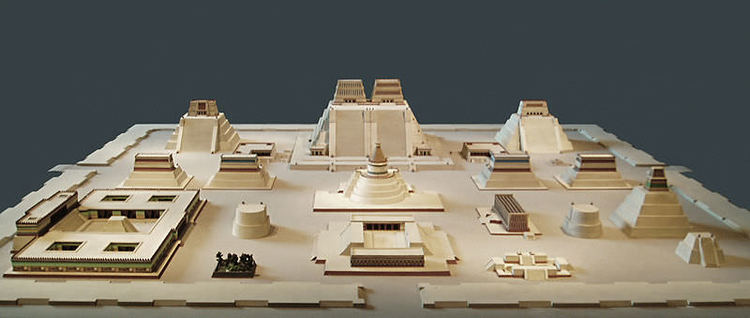
The Templo Mayor, which is the largest building in this model, was actually not that old when the Spanish arrived. Started around 1430 and enlarged by successive Mexica rulers, it probably looked like this from around 1502 so it was only in its full glory for about two decades before Cortés destroyed it. It had two pyramidal towers on top, one dedicated to the rain god Tlāloc and the other to the god of the sun and war, the blood thirsty bastard, Huitzilopochtli. The Templo Mayor was the principal religious site of Tenochtitlan and the scene of the horrific human sacrifices that have left the Mexicas with a reputation as bad as the Nazis and probably deservedly so.
While the Spanish did burn, pillage and create mayhem on a scale that seems unimaginable today given their pathetically small numbers, they could not erase all traces of the Templo Mayor. It is one of the most important archaeological sites in Mexico and should be on every visitor’s list of places to see in Mexico City. Here are the highlights of what you will see.
Visiting Templo Mayor
For a city so large, its somewhat surprising that many of the most popular tourist destinations are all within walking distance of each other in the Centro Histórico. These include the National Palace with its amazing Diego Rivera murals, the massive Metropolitan Cathedral and the Zócalo, the third largest plaza in the world after Red and Tiananmen Squares. And of course, right beside the cathedral is the Templo Mayor. The entire area is a UNESCO World Heritage Site. Visiting all these places, plus just taking in the events that are always going around around the Zócalo, makes for a very satisfying day of playing the tourist.
I would suggest putting aside about two hours for the Templo Mayor which consists not only of the archaeological remains, but also the excellent museum which houses many of the most important finds from the Sacred Precinct. Before going down the steps that lead to the entrance to the site make sure to check out the series of outdoor models that depict first the entire area around ancient Lake Texcoco with Tenochtitlan on an island in the centre of the area.
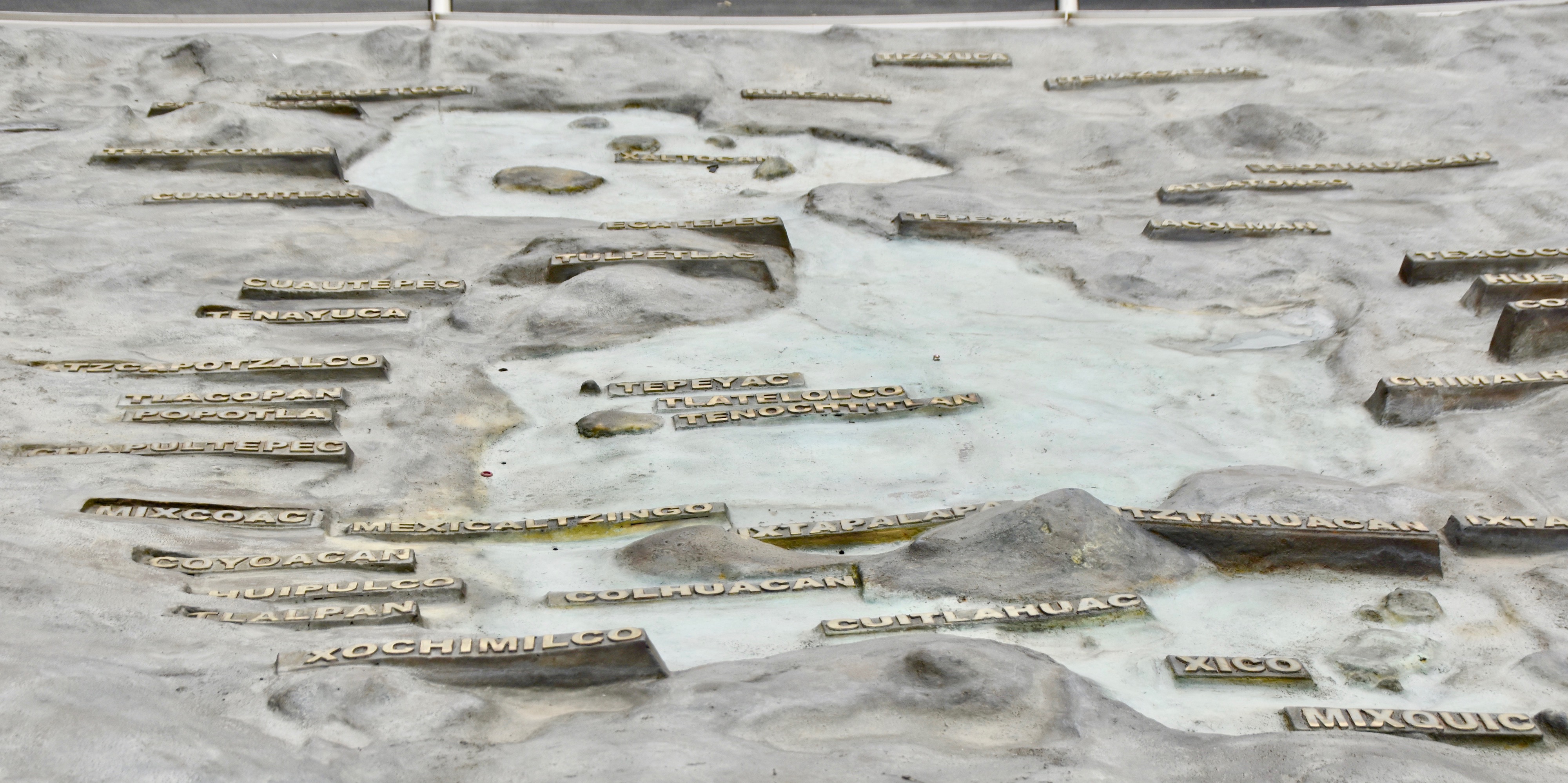
The second zeroes in on Tenochtitlan and gives one an idea of the immensity of this city at the time of the last ruler, Moctezuma (not Montezuma as his name is usually mistakenly pronounced).
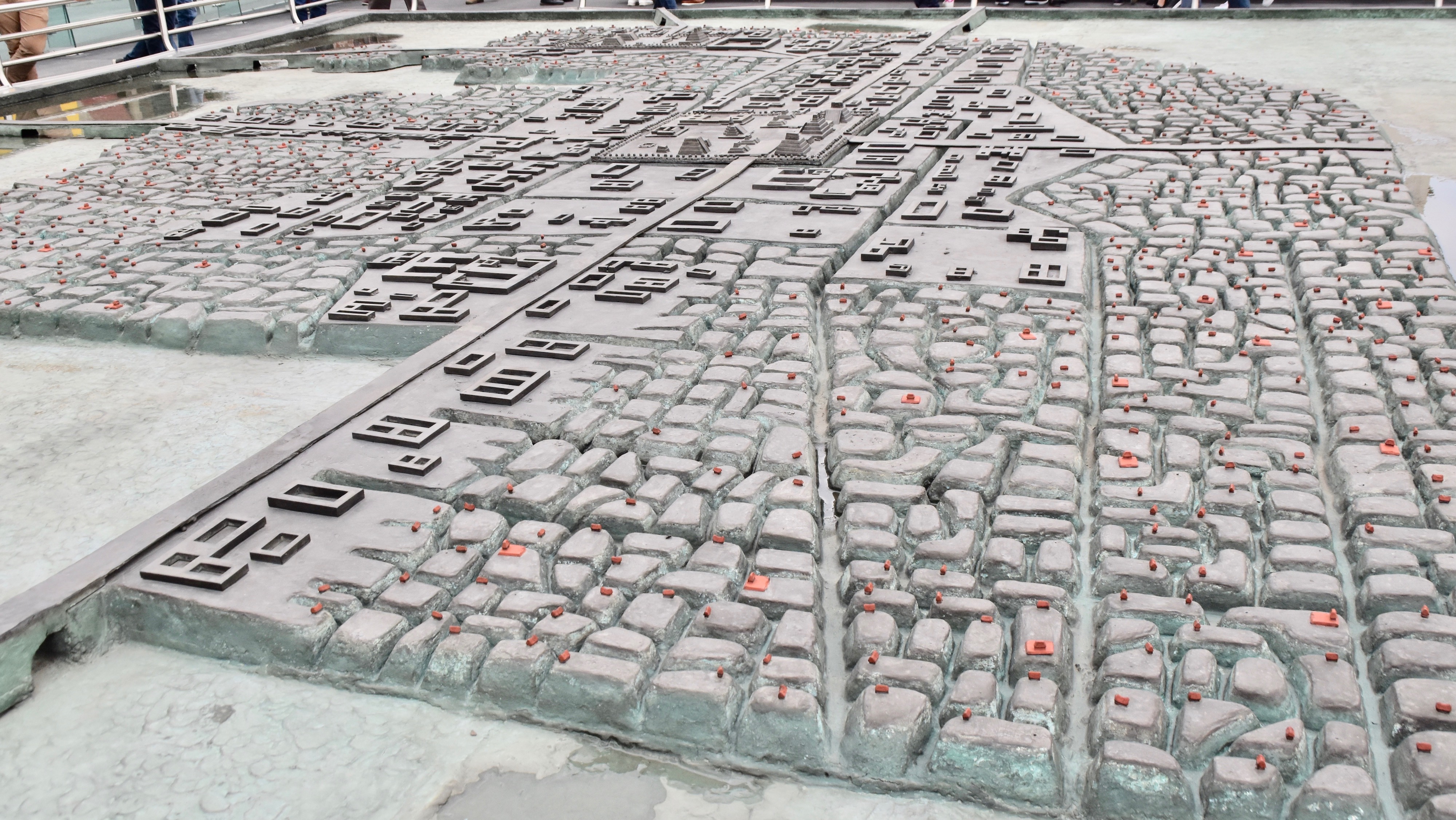
The third zeroes in more, depicting the Sacred Precinct with Templo Mayor and the lesser temples around it. This gives one a good perspective on what was once there to compare it to what is left today.
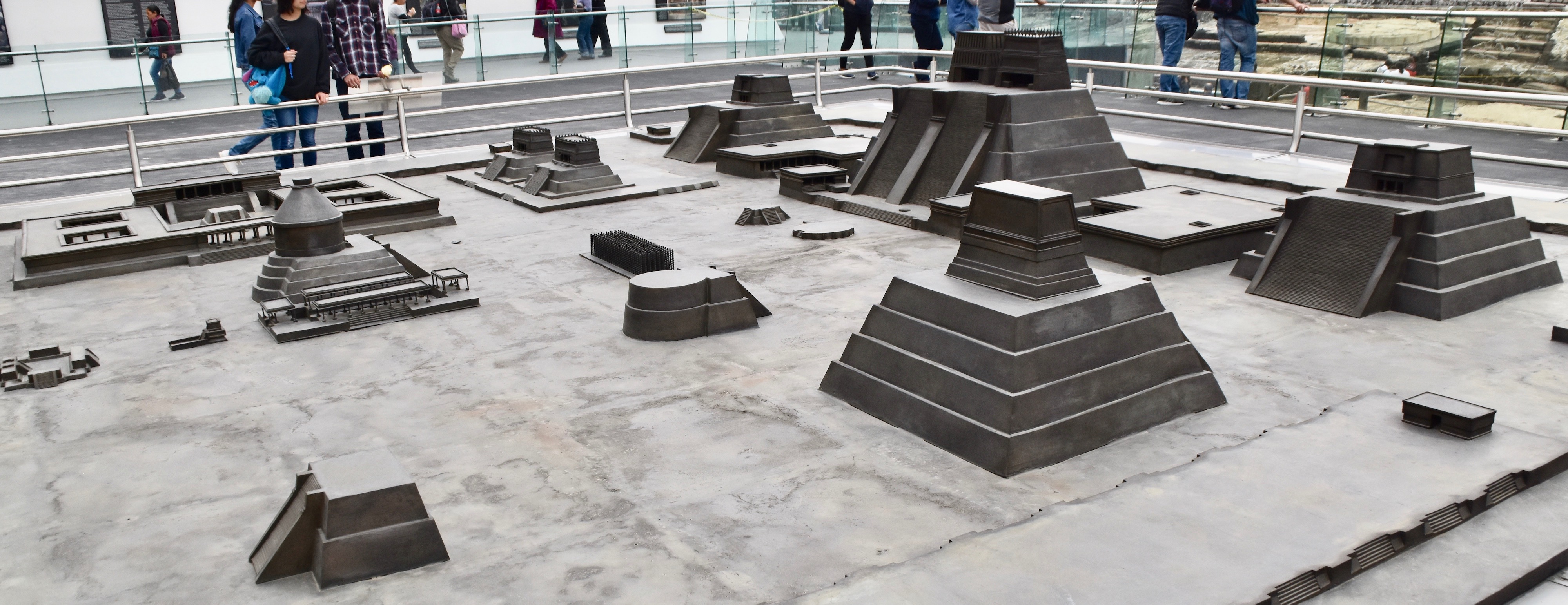
Finally, just inside the entrance you will find a model of Templo Mayor showing the different layers that were added over the years to make it larger and the manner in which it was painted – blue for Tlāloc’s temple and, not surprisingly, red for Huitzilopochtli’s.
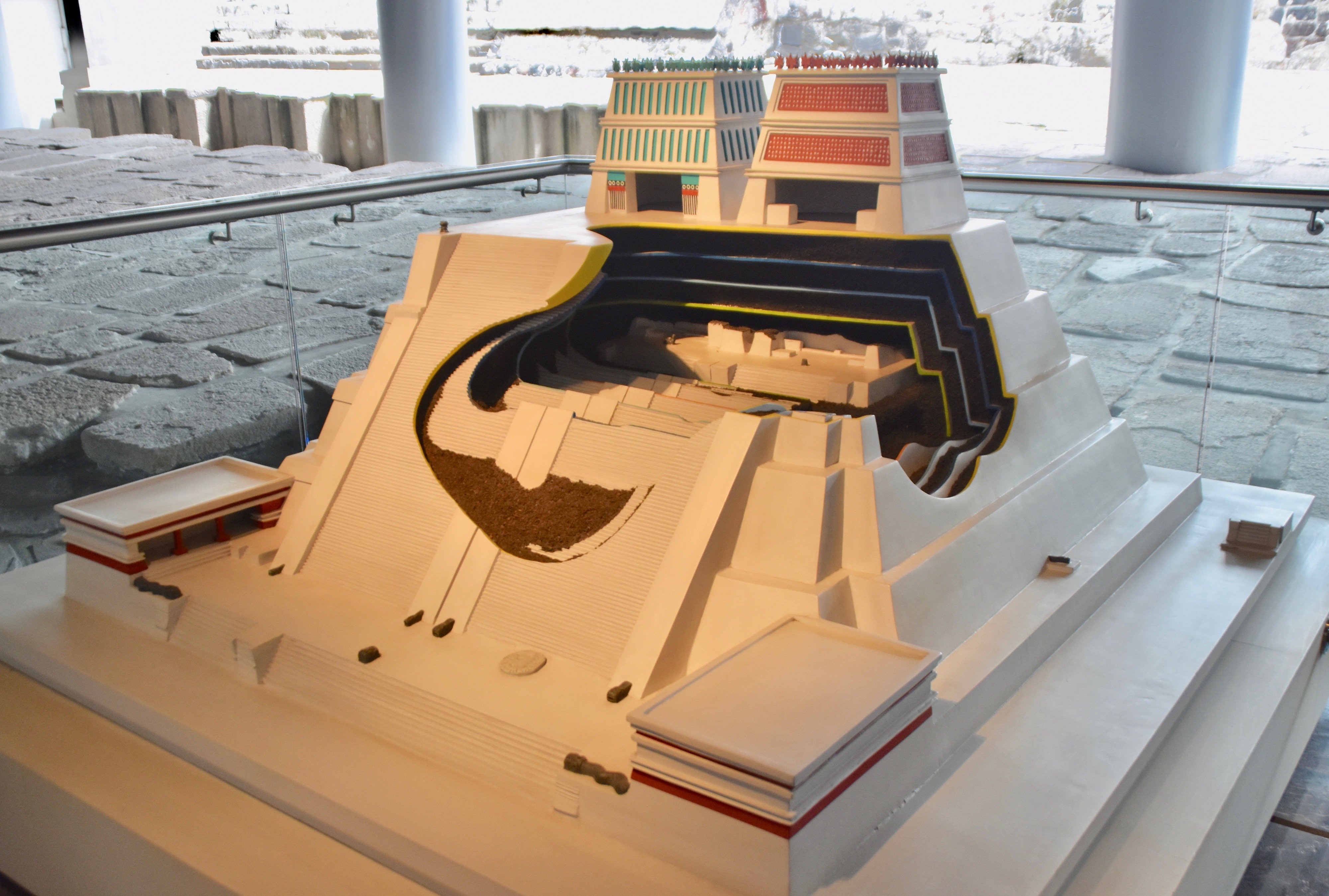
After paying the 75 peso (4USD) admission fee you follow a designated route through the remains of the outer Sacred Precinct into the museum, which also has a designated route through it and out again into the archaeological remains and the exit.
The Sacred Precinct was surrounded on all sides by a wall, the remains of which are still intact in places. The Serpent Wall as it was called features a number of representations of snakes including this slithering creature. Snakes were very much a motif in Meso-America, particularly on the form of the feathered serpent god Queztlcoatl.
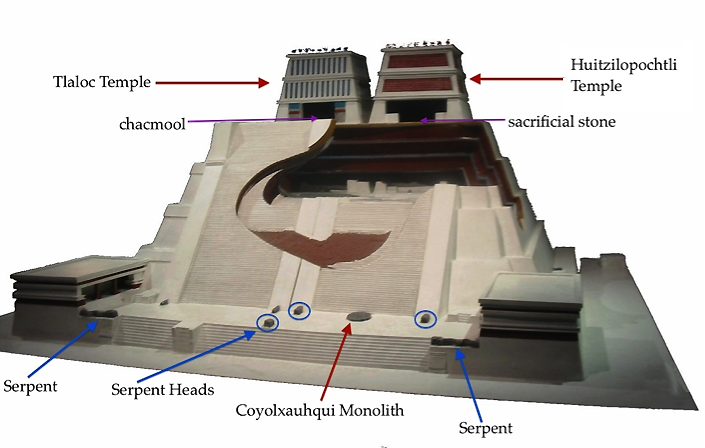
This is a representation of Templo Mayor showing the placement of the serpents. Today of course, there is nothing left that stood much higher than where the serpents are today. The Spanish did such a great job of destroying Templo Mayor that no one even knew where it stood until workman stumbled upon the site in 1978. If you want to see actual standing temples you need to go to Teotihuacan just outside the city. I’ll be posting on that site later in this trip.

Here are two frogs with the head of a huge snake seemingly coming up to them from the side. They are on the Tlāloc side of the Templo Mayor and because of their affinity for water, associated with the rain god.
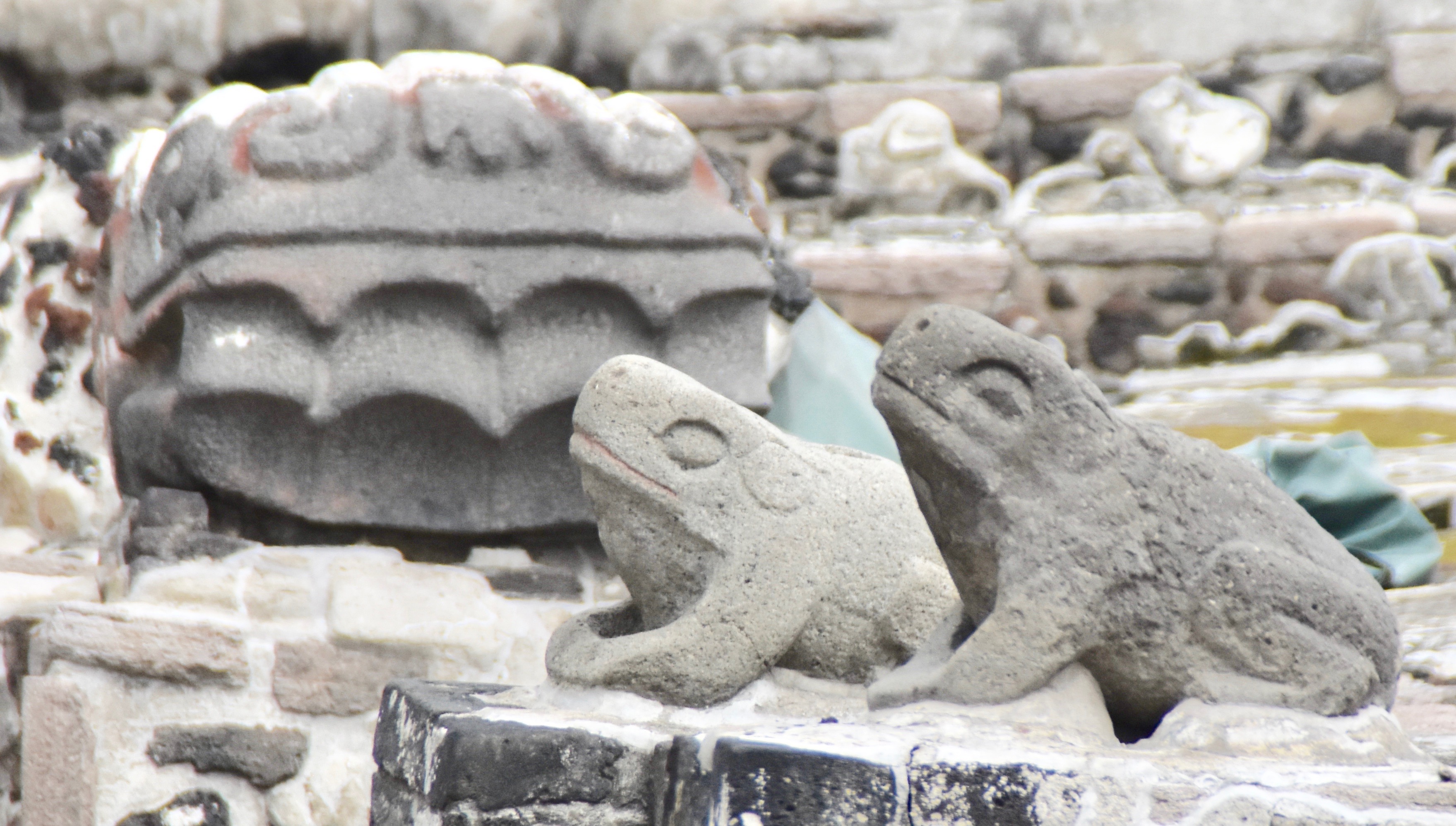
The primary building material for the Templo Mayor and most of the other structures that have been excavated in the Sacred Precinct was lava rock held together with a plaster made from limestone. Then the whole facade was covered with stucco.
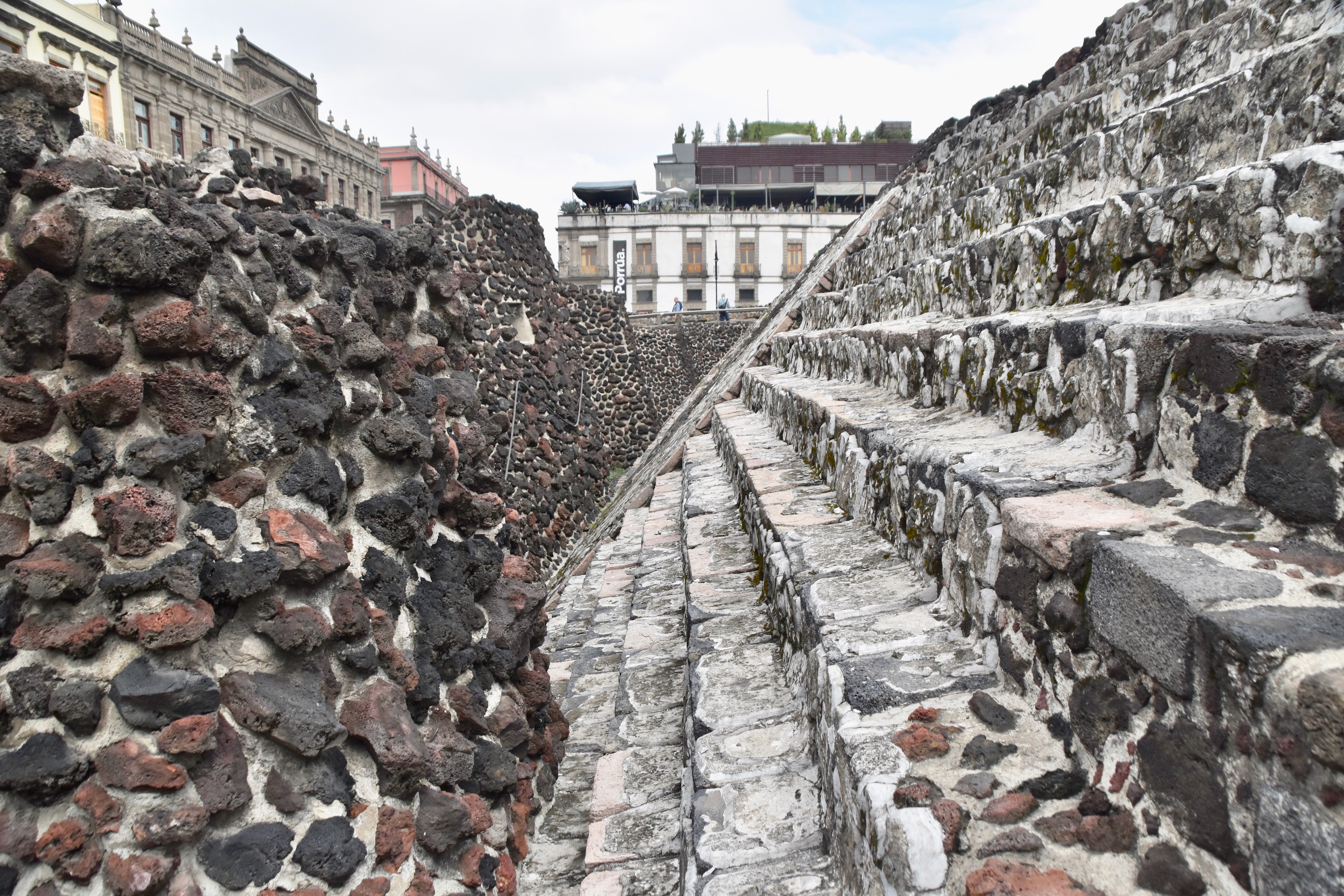
This photo shows how, in order to enlarge a pyramid temple, the Mexicas simply encased the existing structure with a new shell, filling in the space in between with more lava stones.
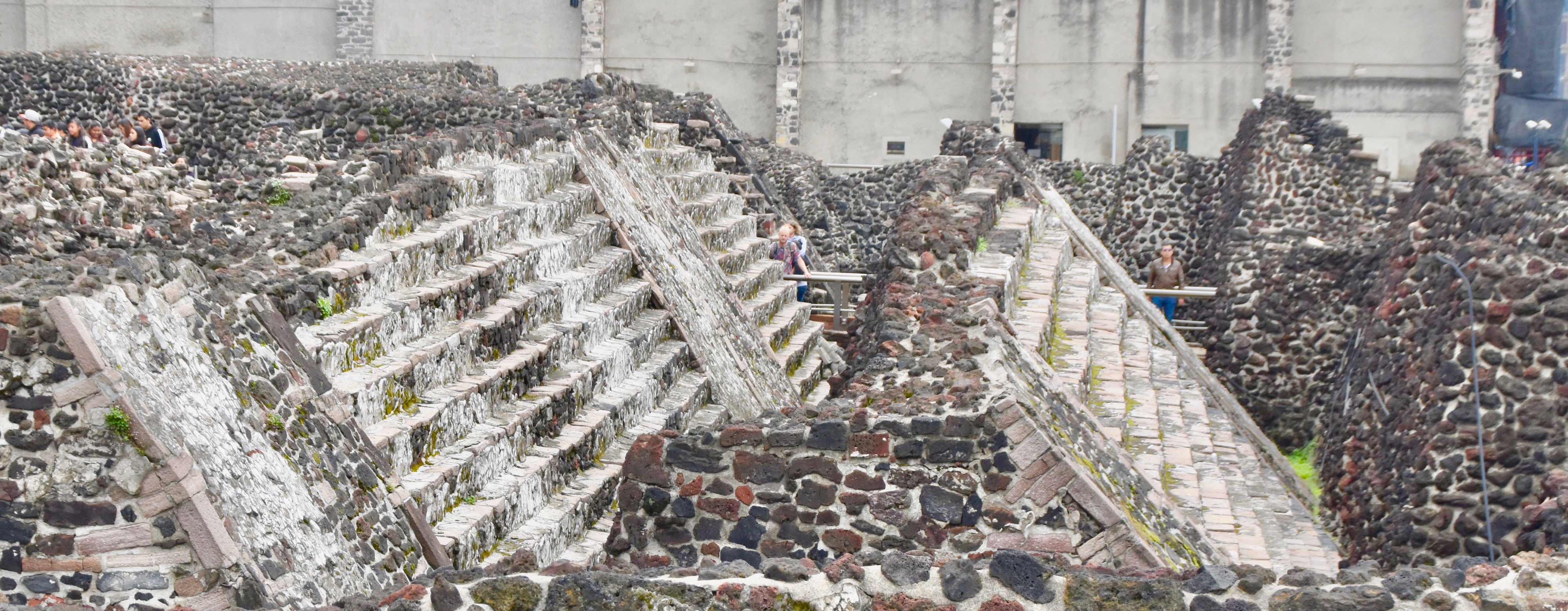
These standard bearers may represent three of the 400 siblings of Coyolxauhqui, the Moon Goddess, who conspired with her to prevent the birth of Huitzilopochtli, the future god of war. Needless to say, just like with the Greek titan Cronus trying to prevent the birth of Zeus, it didn’t work. We’ll find out what happened to Coyolxauhqui once we get inside the museum.
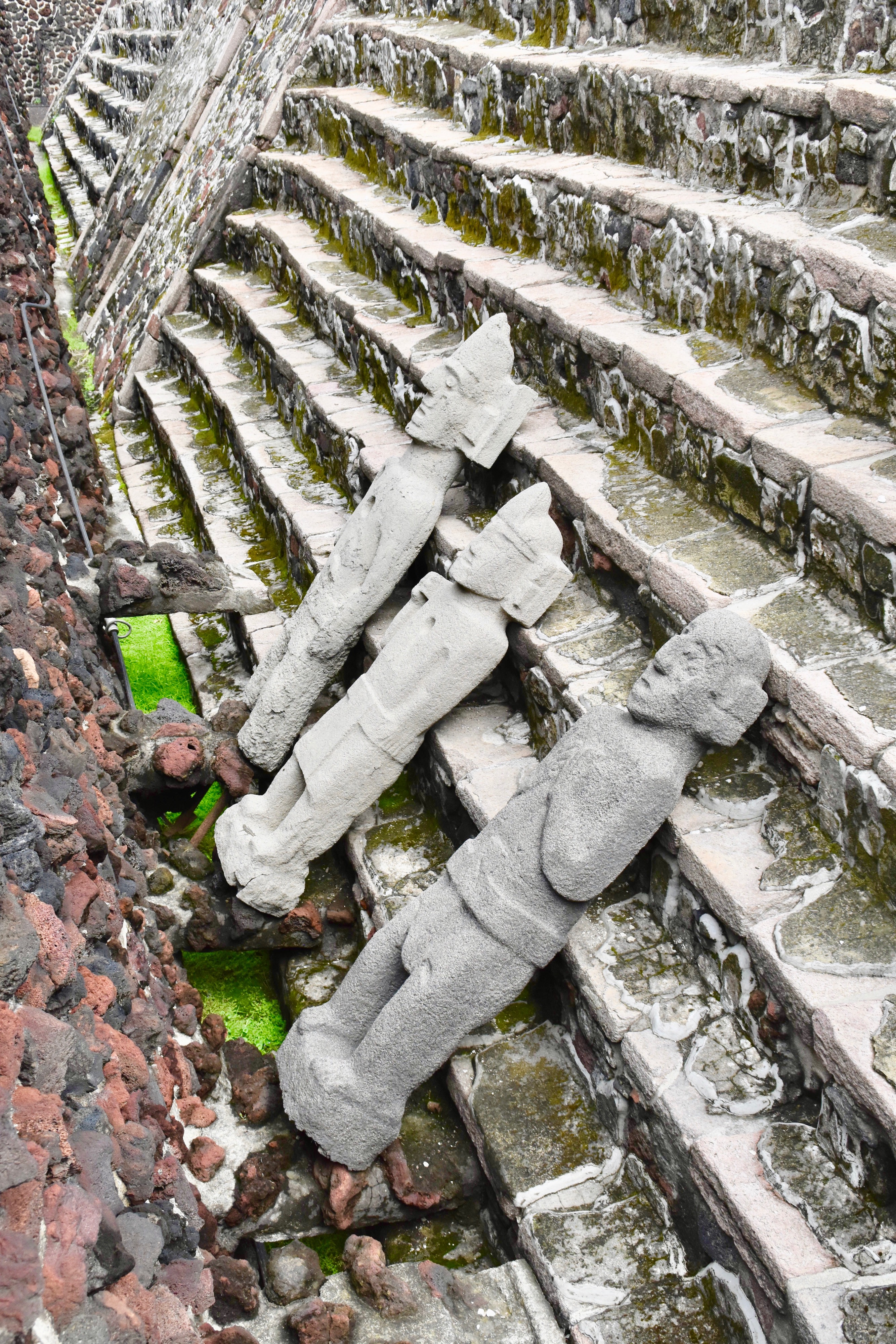
The pathway tends to wind from one side of the front of the Templo Mayor to the other so you get figures like the frogs related to Tlāloc and then the standard bearers on the Huitzilopochtli side and back again to this figure which is clearly on the Tlāloc team.
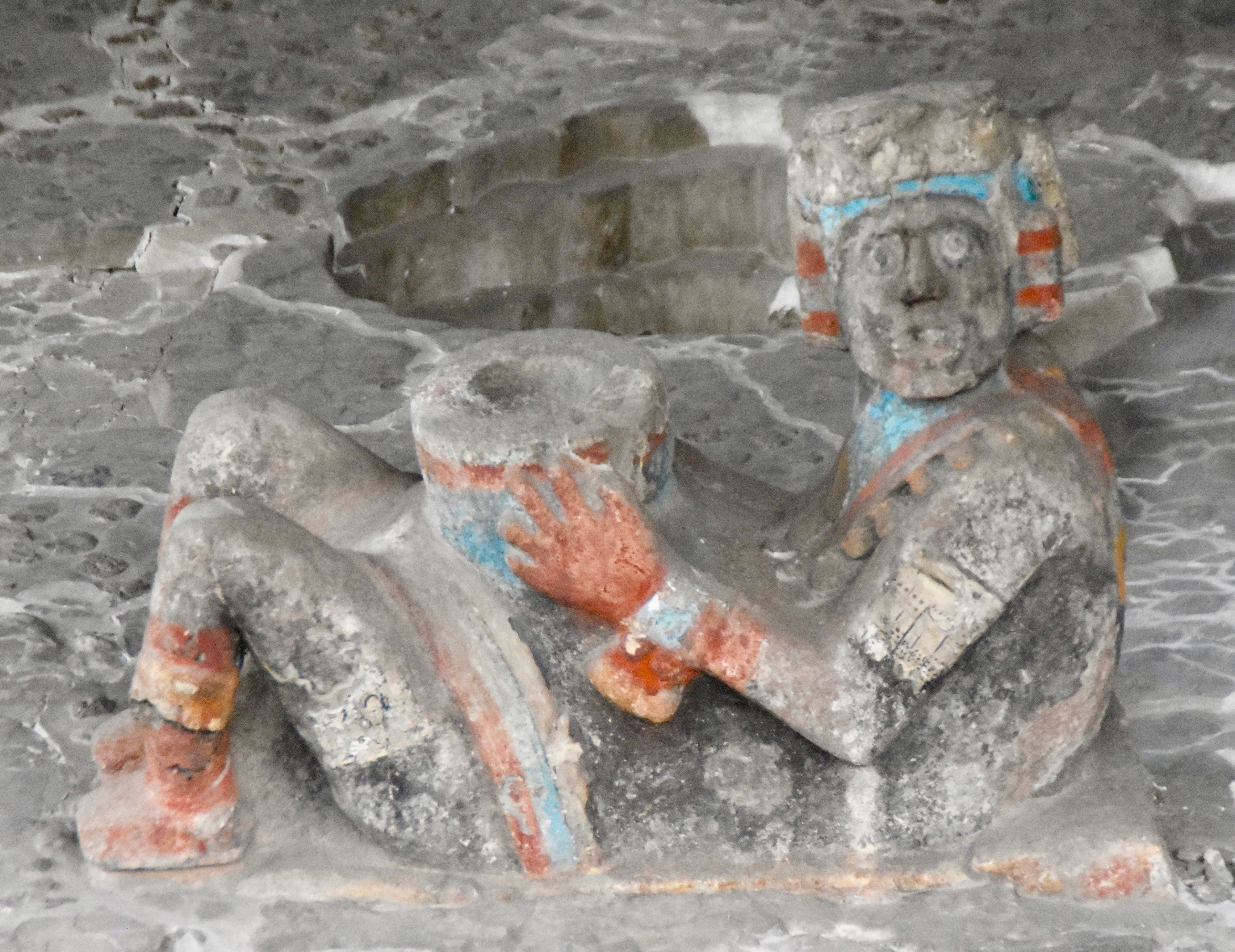
This is a chacmool, one of the most recognizable type of statues found at many sites in Mexico including Tula and Chichén Itzá and always associated with Tlāloc. Looking every bit as surprised as a teenager caught doing something he was told would make him go blind, this chacmool retains much of the original paint. It is one of the best examples of this genre in all of Mexico.
This is the head of an eagle that adorns the outside of a small building that is believed to have been the headquarters of the Eagle Warriors, a group that you could only join by achieving rare success and prowess as a fighter.
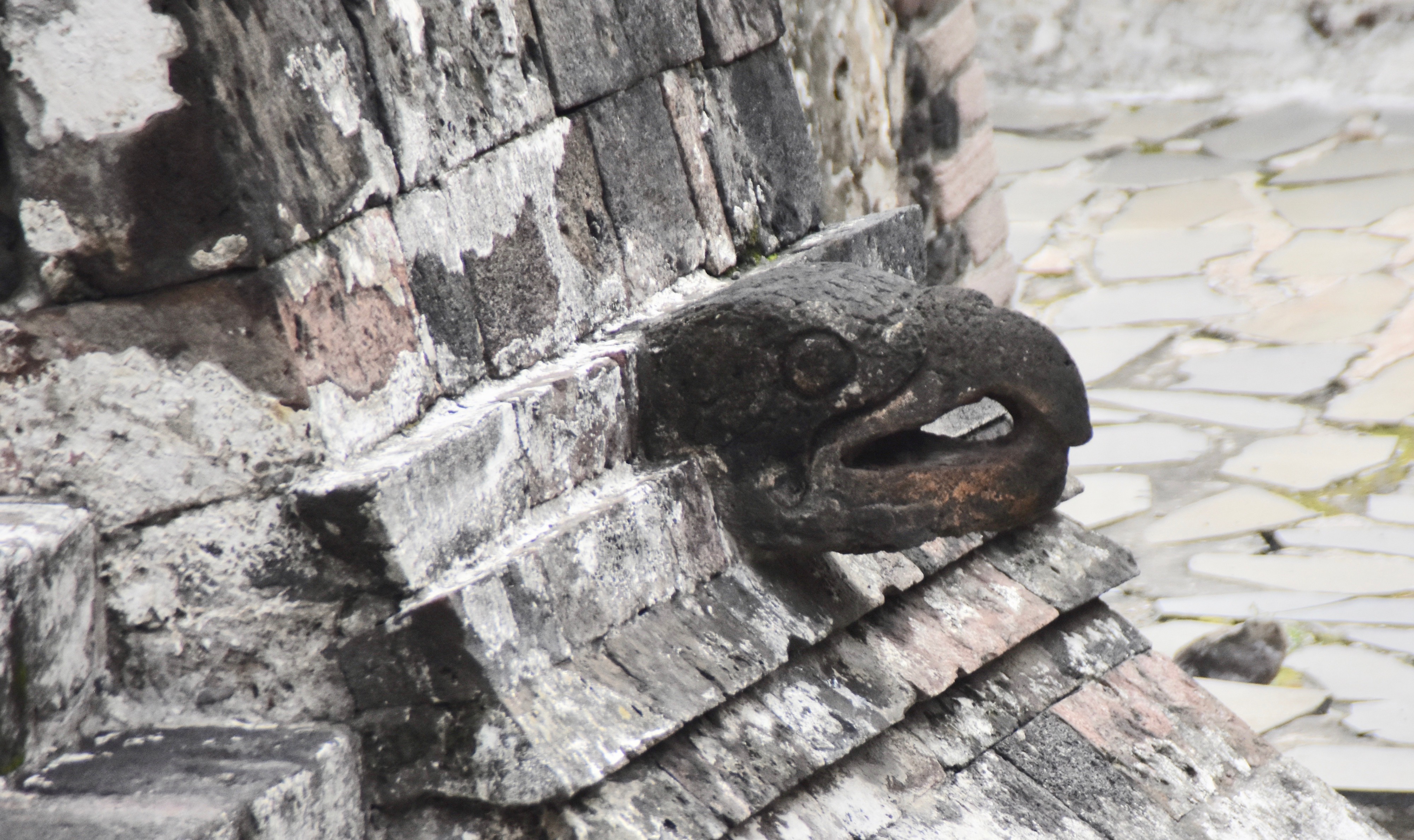
This is how they were thought to look going into battle.
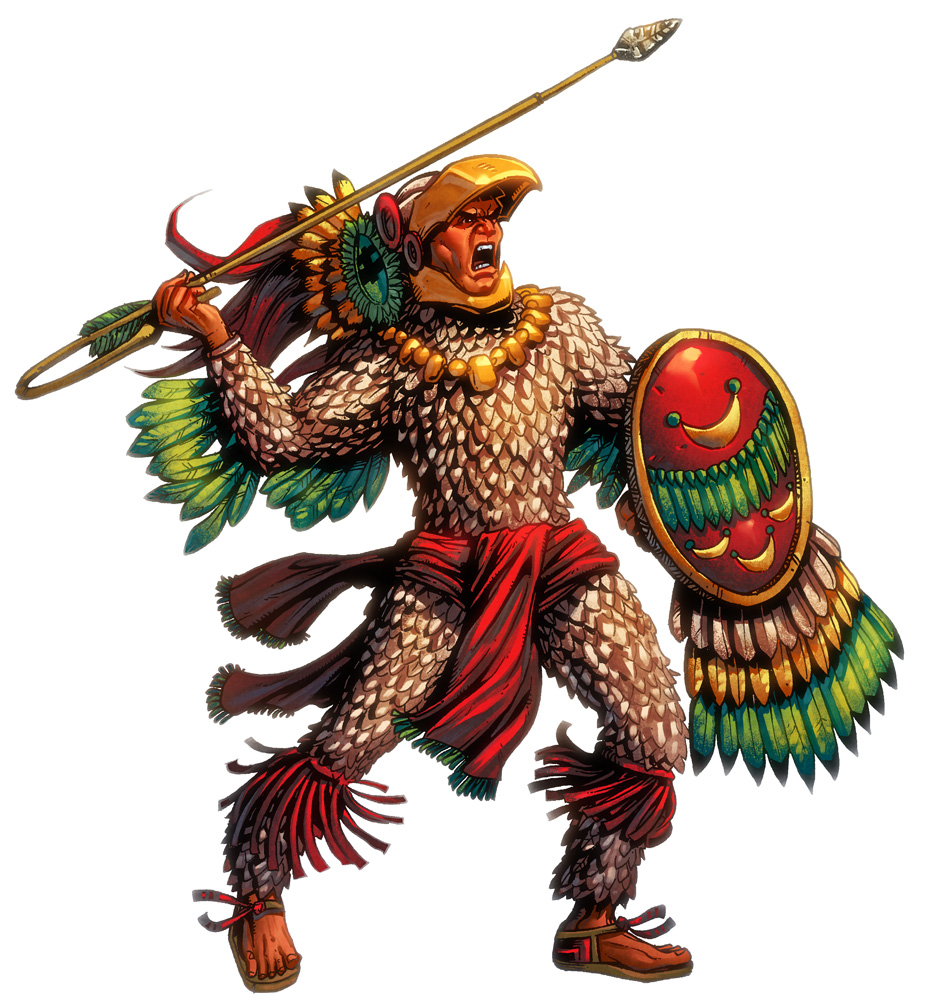
As you near the entrance to the museum you come upon this structure which you know has to be related to the worship of Huitzilopochtli. This is a sculptural representation of a tzompantli or ‘skull rack’ as it is commonly named. These were wooden racks where real skulls would be put on display looking very much as they are depicted here on the North Plaza of Templo Mayor. It is the last important site before entering the museum.
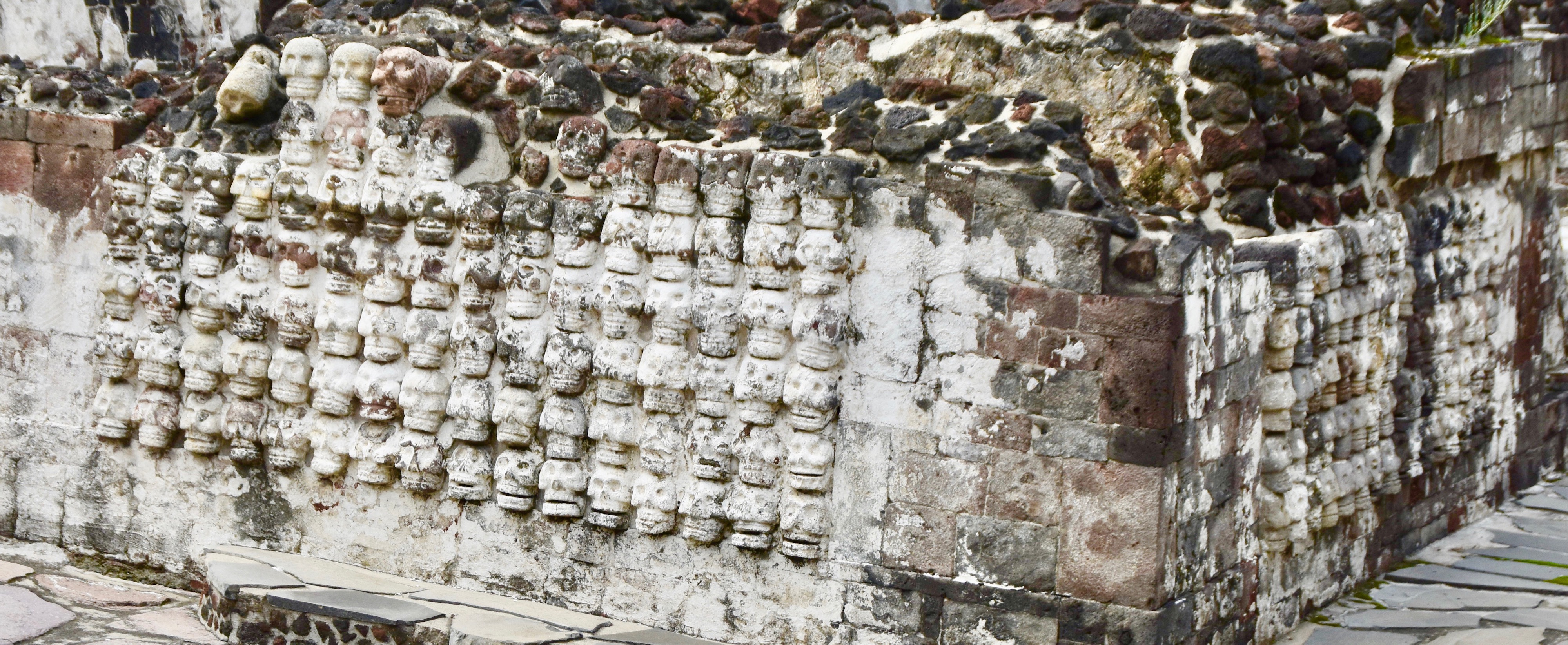
The Museum
The Templo Mayor Museum was opened in 1987 and has eight main galleries, the first four on the site of the Huitzilopochtli temple and the last four on the Tlāloc side. In between there is a great lobby that stretches up four stories. Non-flash photography is permitted.
Starting in at the Huitzilopochtli galleries you get another gruesome scene of multiple sculptured skulls, all found on site, that make up the Cranium Nail Wall. I have to wonder as I look around at all the families who are here with small children, how many are going to be having nightmares tonight.
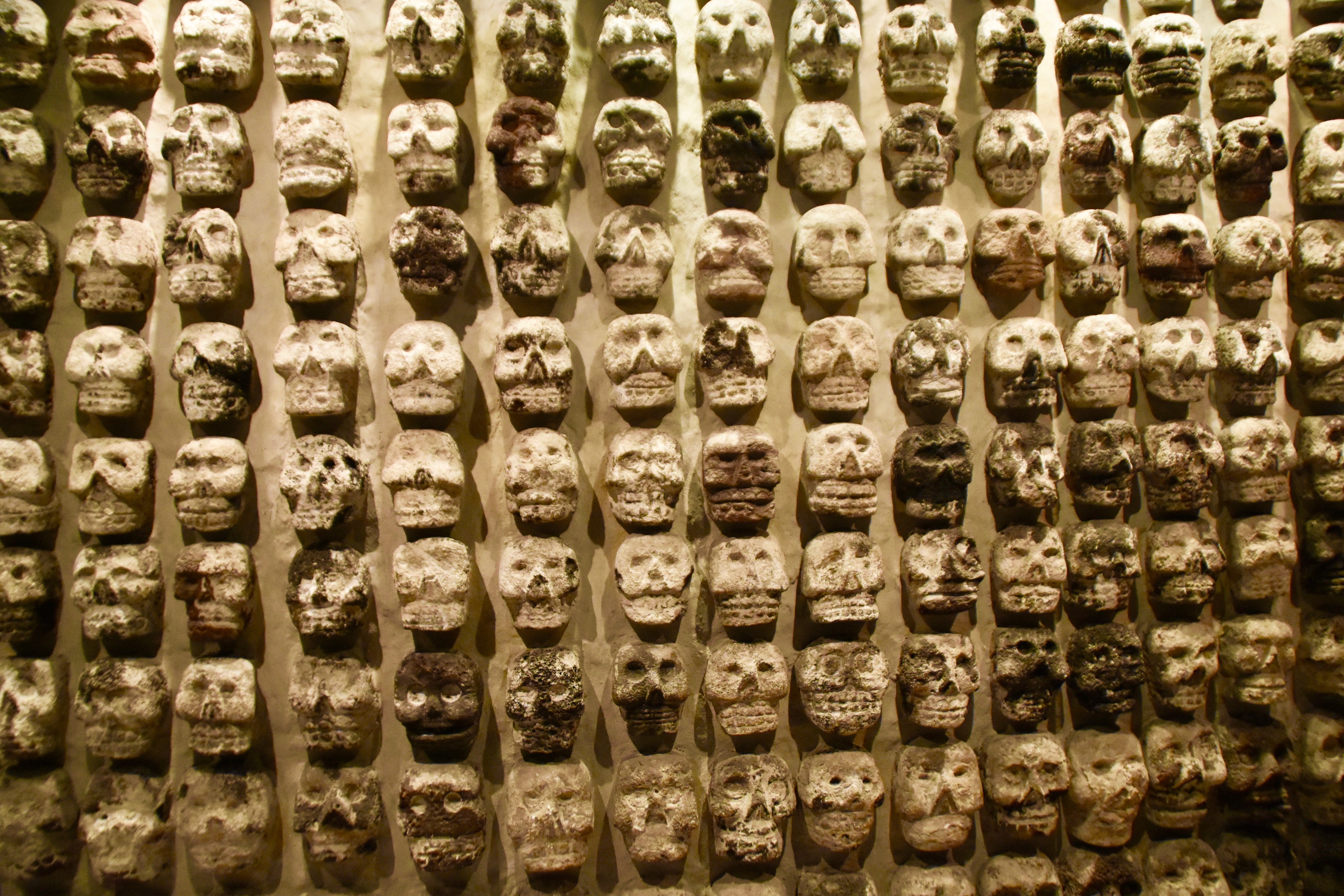
This is the Cuahxicalli Eagle, a representation of a golden eagle with a bowl in his back for receiving the hearts of human sacrifices. To my mind, this was one of the best objects on display. It has a level of detail and an element of horror at what its purpose was, that is fixating.
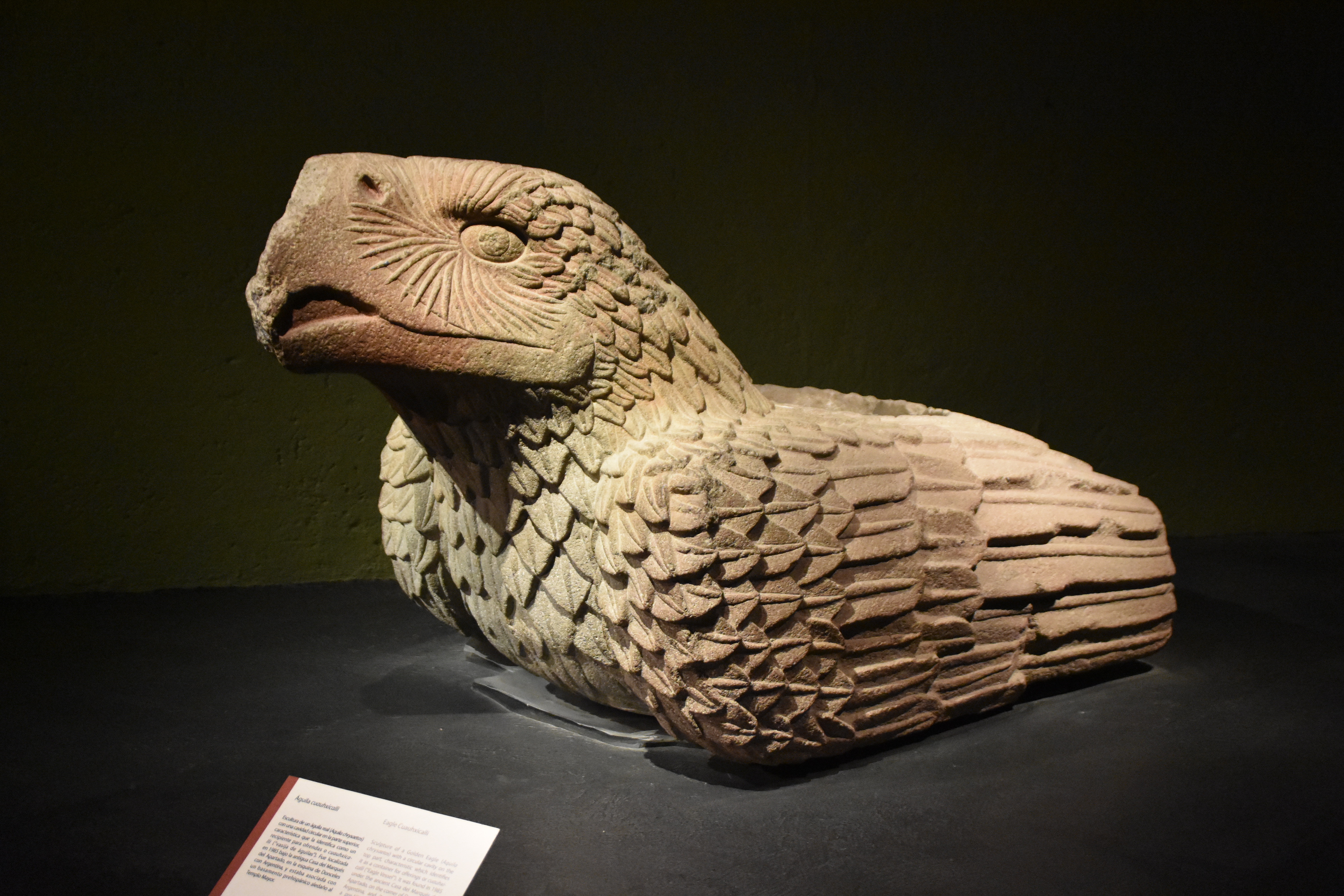
I found this group of artifacts absolutely terrifying. They look so cute, but are actually knives that were used to perform human sacrifices. I had this thought in my head as I thought of a victim in his last moments of life. “Hi, my name’s Mack and I’ll be the one cutting out your heart and disembowelling you. Have a nice day!”.
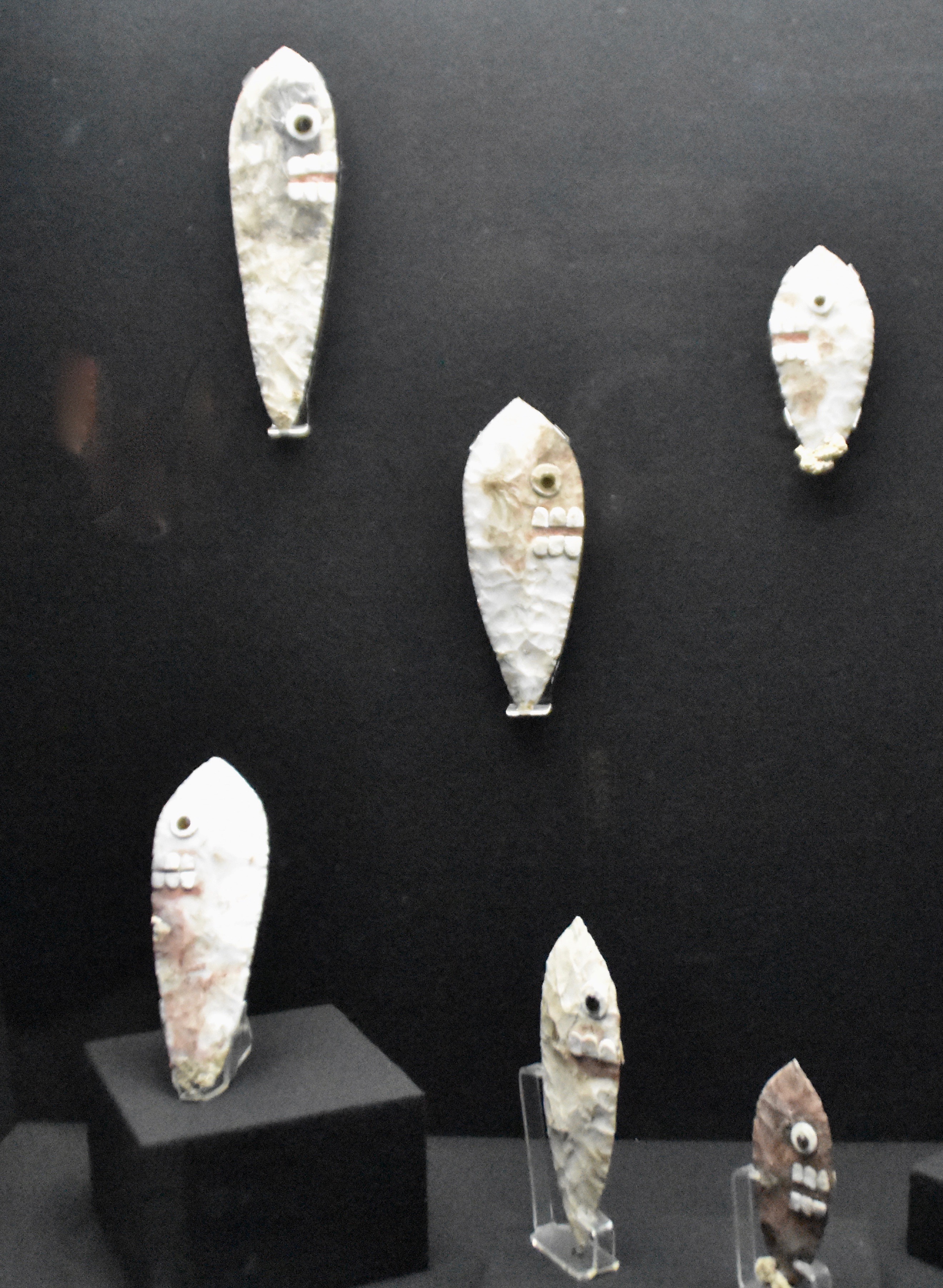
These two wonderfully carved stone masks are not originally from Tenochtitlan, but believed to have arrived here as tribute. The one on the right is from Teotihuacan and is made of green stone with shell and obsidian inlay. It is believed to have been at least eight hundred years old by the time it arrived in Tenochtitlan.
The one on the left is also from Teotihuacan, this one carved from serpentine and also much older than Tenochtitlan.
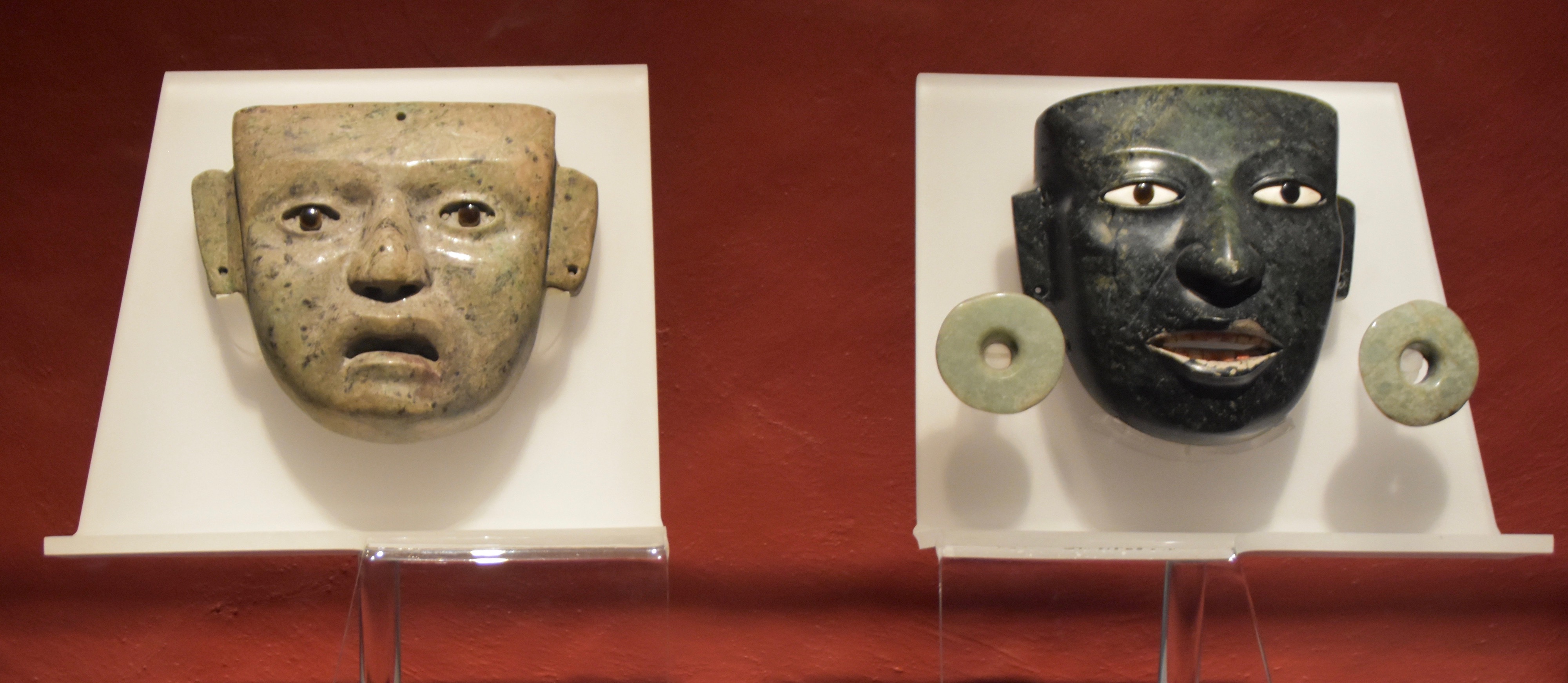
Even more amazing is this Olmec greenstone mask which is over 3,000 years old! In other words, when the Mexicas got their hands on it, it was farther removed in time from their era than Jesus or Socrates is from us. Unfortunately, my photo did not turn out so I got this one from Pinterest.
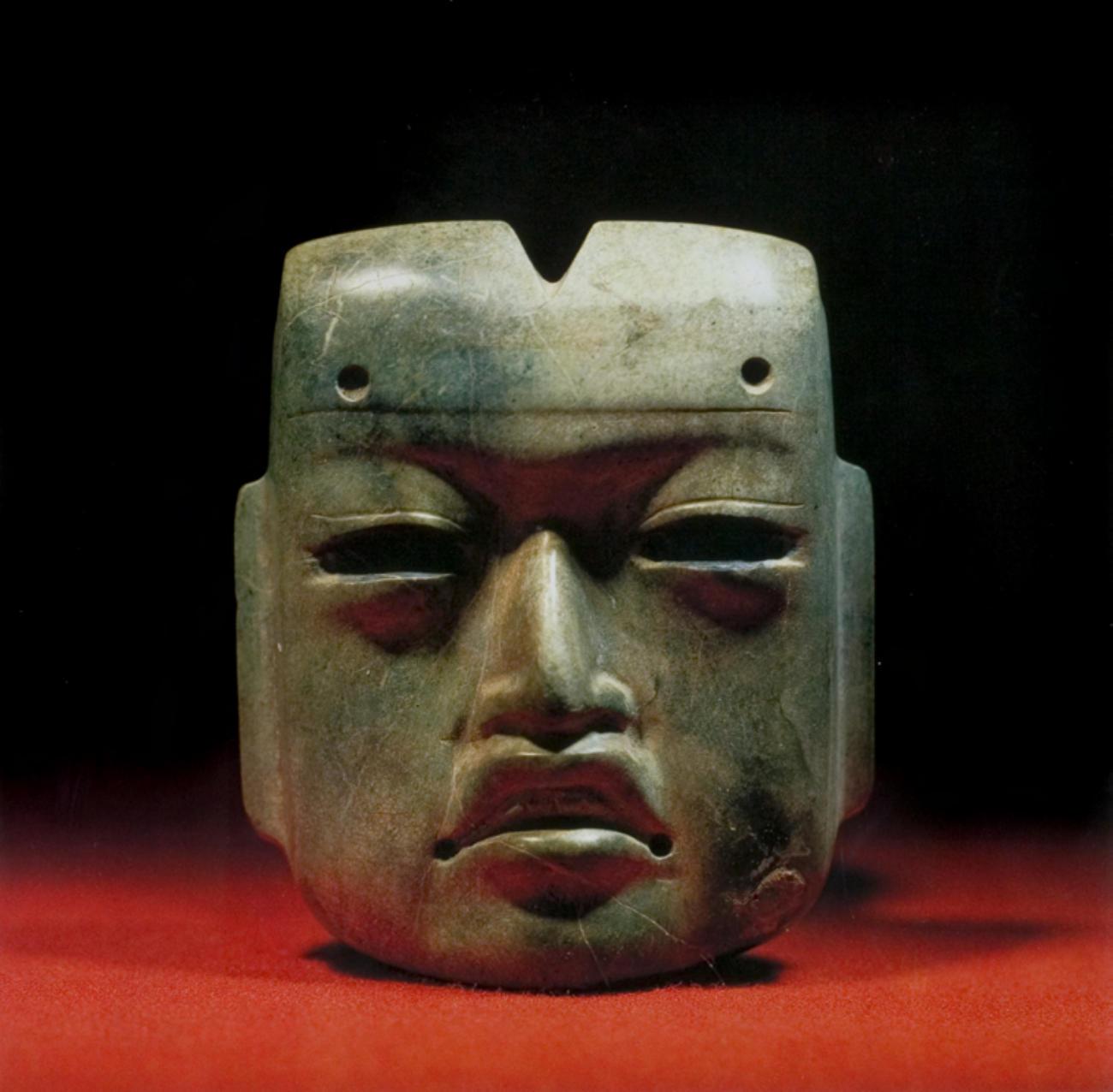
This horrible looking creature is Mictlanecuhtli the God of Death and a Meso-American version of Hades, ruling over the underworld.
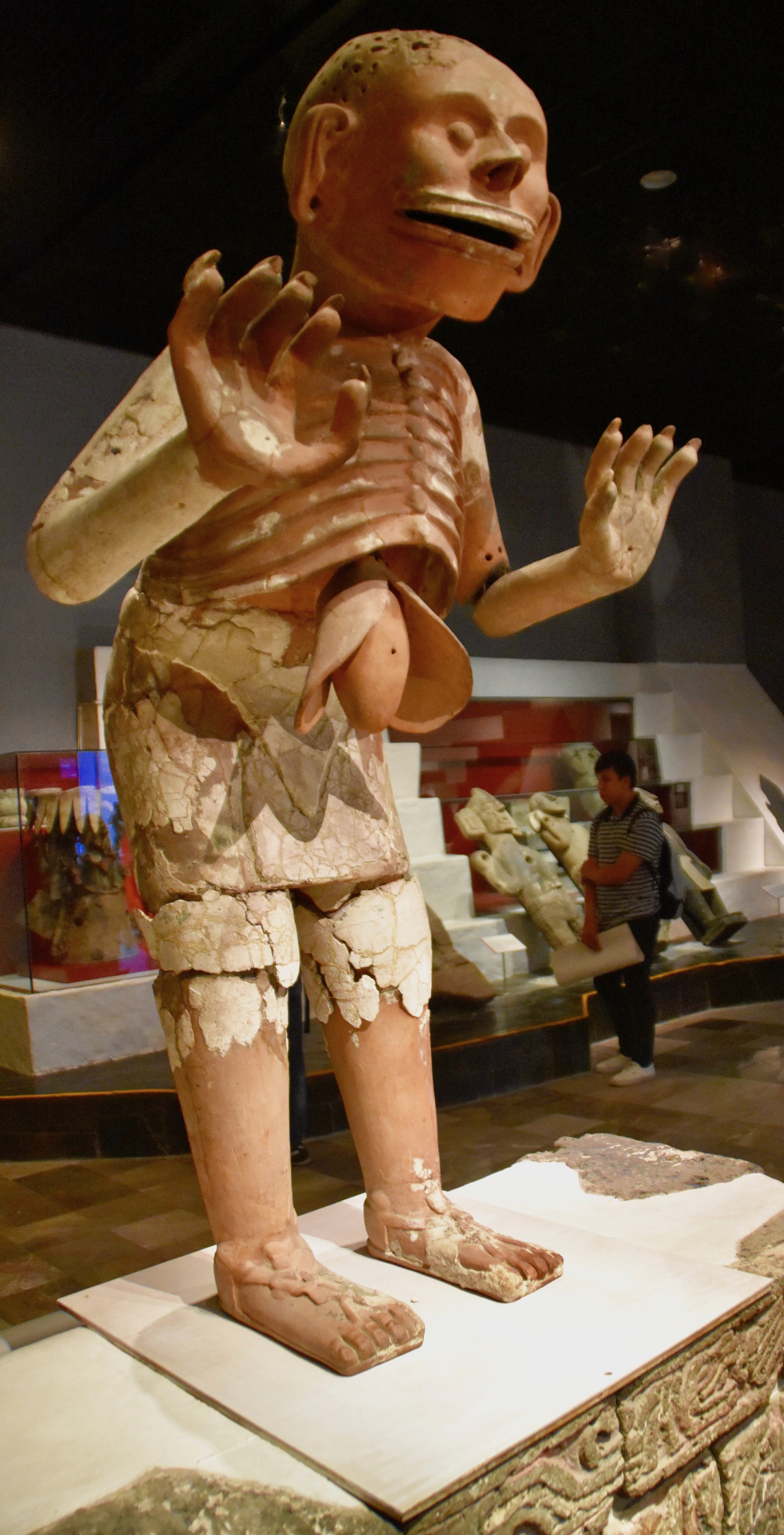
This is a sculptural representation of one of the eagle warriors who had their headquarters at Templo Mayor. Both this and Mictlanecuhtli are quite large and imposing, standing almost side by side in one of the last galleries.
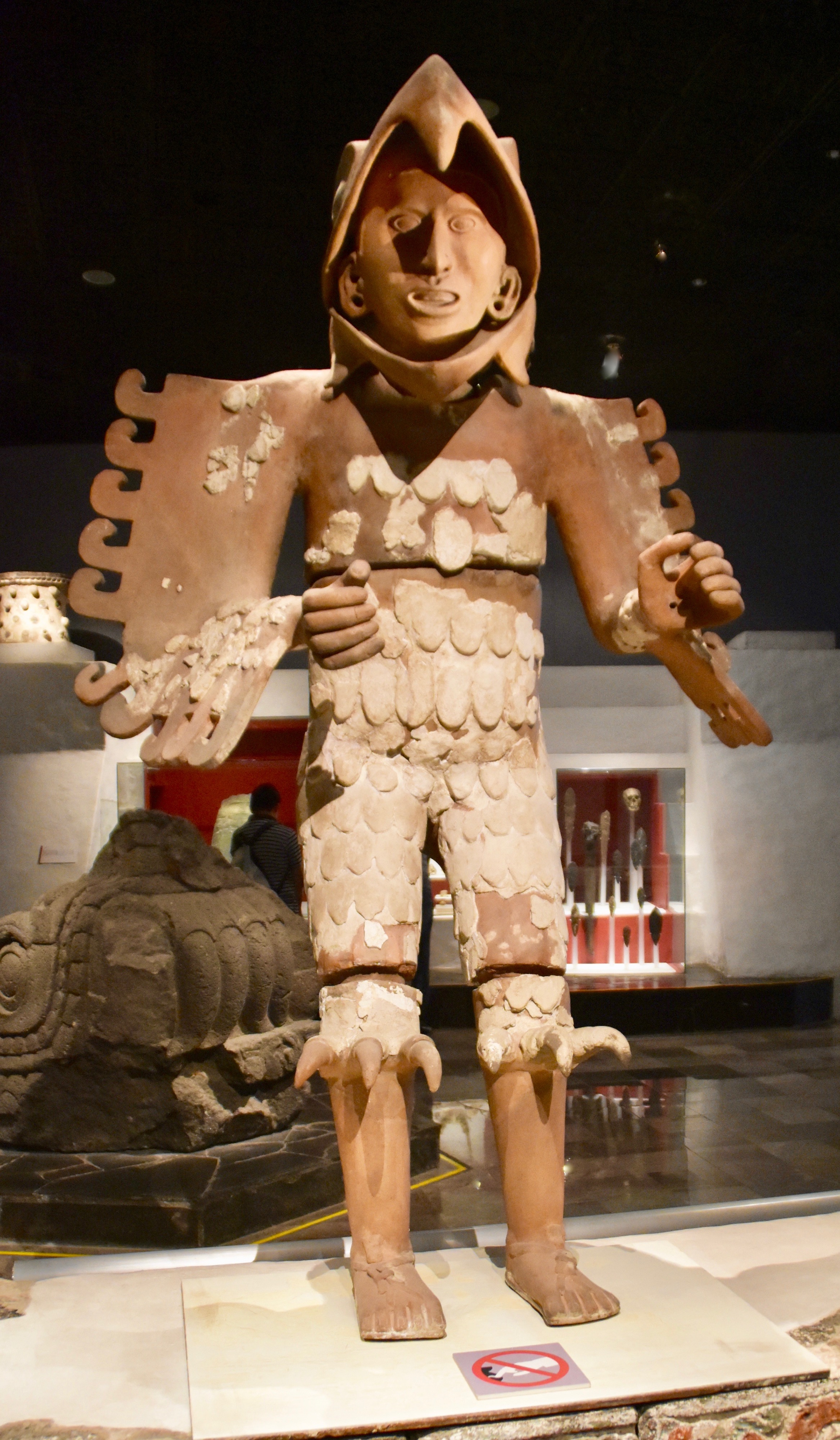
This is the most famous object in the Templo Mayor Museum – the Coyolxauqui Monolith. I mentioned her earlier as one of the conspirators trying to prevent the birth of Huitzilopochtli, which she failed to do. In revenge her newly born brother killed her by throwing her off a mountain where her body broke into many parts. This stone depiction is eleven feet across and you look down on it from the floor above. The more you look you can see that she has been dismembered and body parts arranged into a circle. It’s very impressive.
This was the artifact that spurred the hunt for the site of Templo Mayor when it was stumbled upon in 1978 by electrical workers. It was later identified as having been placed at the bottom of the stairs that led up to the sacrificial altar in front of the temple.
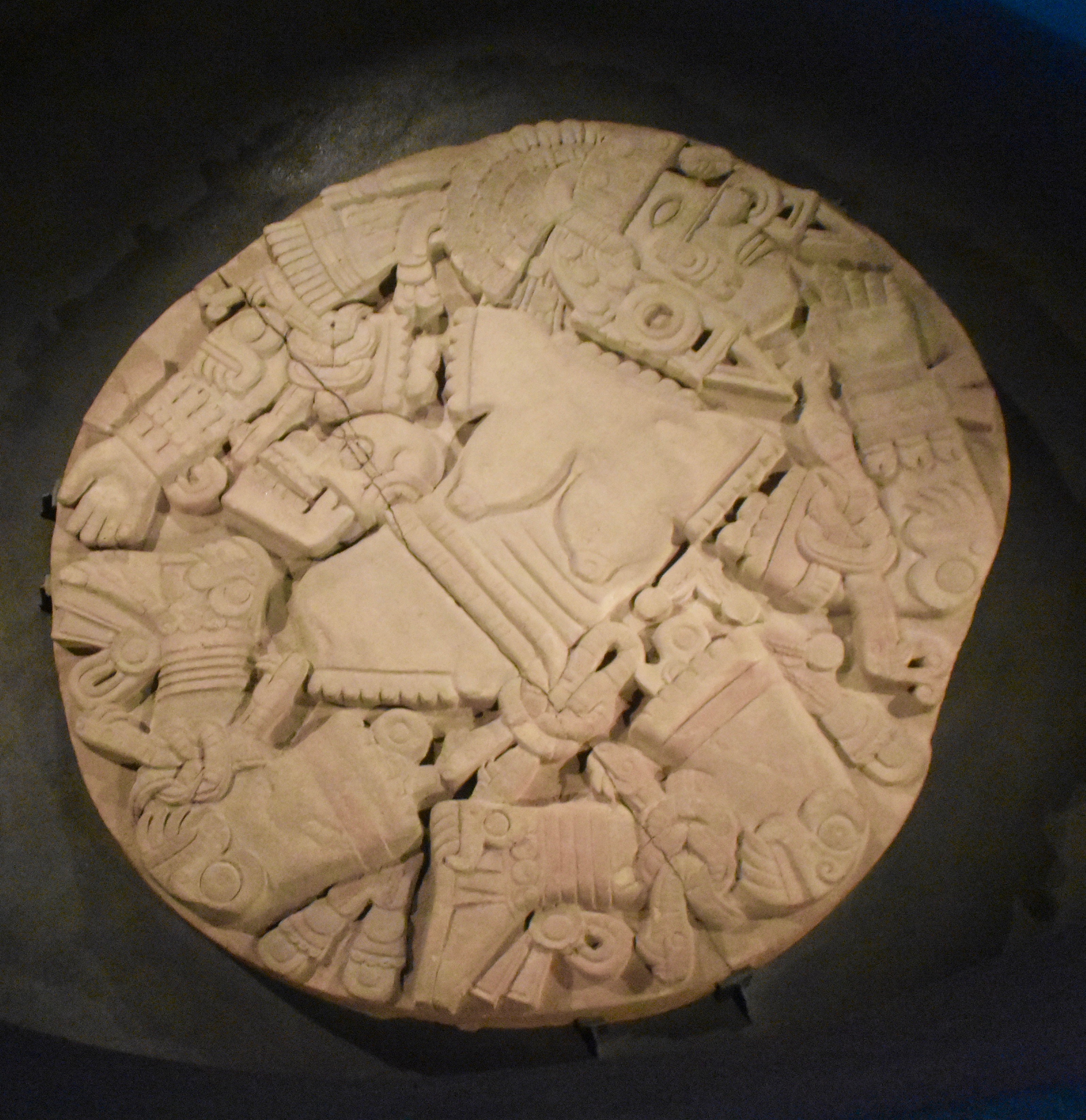
After this last stop on the museum tour you exit the building to this scene which reflects the three ages of Mexico City. In the foreground are the last remnants of the Mexica Empire of Tenochtitlan, then the Metropolitan cathedral representing the colonial era and in the background the Torre Latinoamerico, representing modern Mexico City. I’m sure both the Mexicas and the Catholic church thought they would rule the area for time immemorial and who knows what the future will bring.
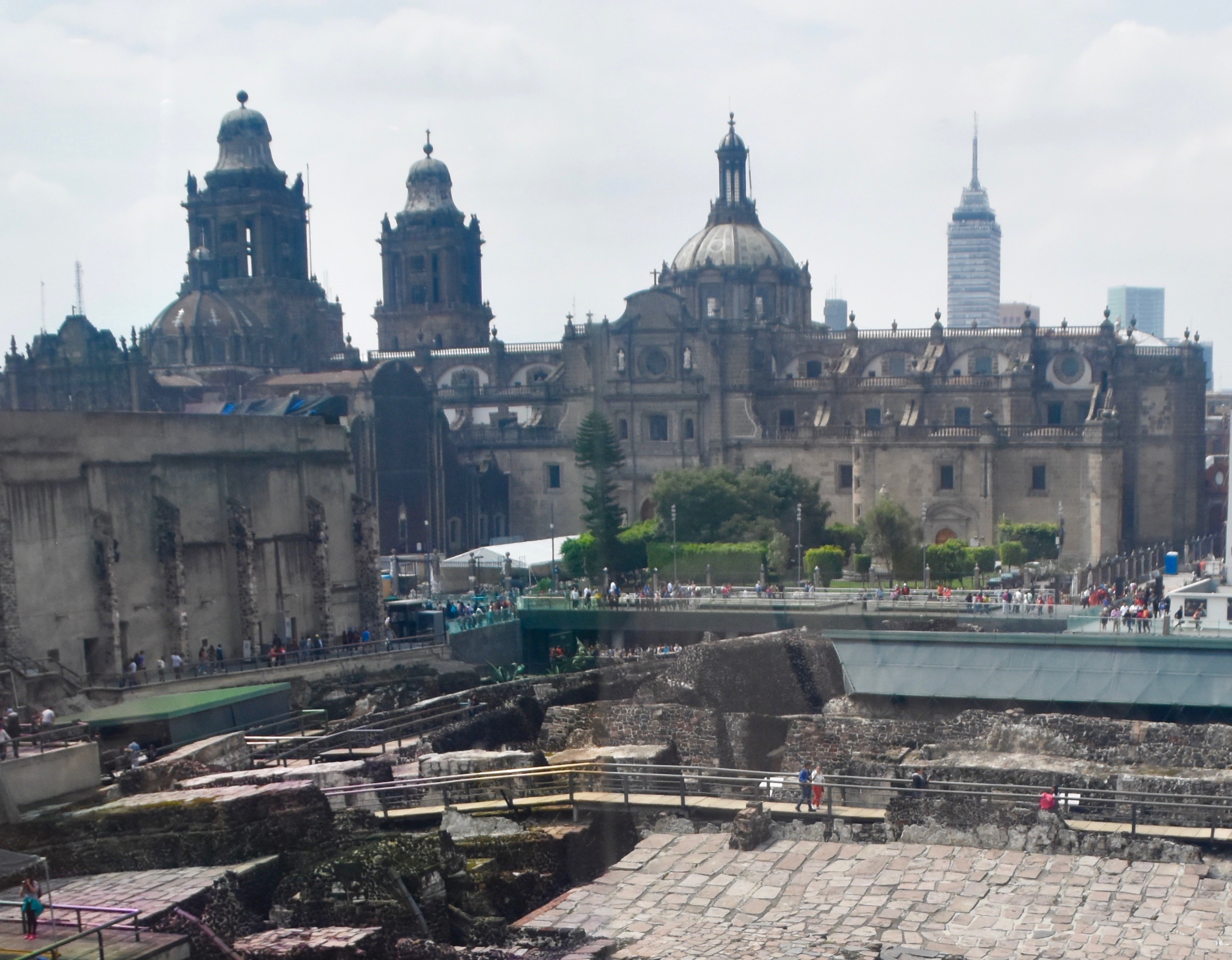
For other posts on Mexico City have a look at Xochimilco, Coyoacan and the National Museum of Anthropology.

